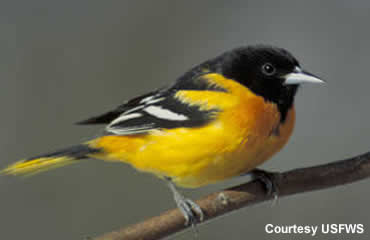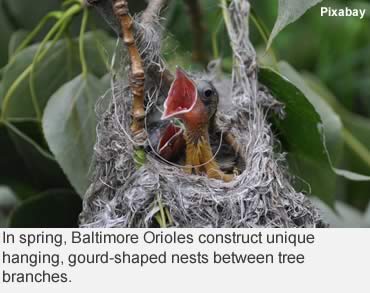Photo: An adult male Baltimore oriole enjoys his favorite grape jelly snack at a feeder.
During February 2017, for the third year in a row, South Carolina became known as the state most favored as a winter home by migrating Baltimore Orioles.
Baltimore Orioles are neotropical migrants, normally wintering in South and Central America and migrating to North America to nest. During the last few decades, however, this colorful species has begun wintering annually in the Southeast.
During late August and September alert birdwatchers will be able spot Baltimore Orioles returning to the Southeastern state.
Discovering just how many Baltimore Orioles now call South Carolina home for winter happened during the third annual South Carolina Department of Natural Resources Baltimore Oriole Winter Survey conducted this past February, and held in conjunction with the Great Backyard Bird Count.
By tapping into the long-standing Backyard Bird Count citizen-scientist project, it created a better picture of the status and distribution of the beautiful songbird.
Orioles were recorded in 16 South Carolina counties and ranged from Upstate, through the Midlands and along the coast, from North Myrtle Beach to Hilton Head. Charleston County recorded the largest number of orioles in the state, recording more than a third of the total number for the state.
 Other counties with good numbers of orioles recorded were Dorchester, Sumter and Horry. Reports were received from Newberry and Hampton counties for the first time this year.
Other counties with good numbers of orioles recorded were Dorchester, Sumter and Horry. Reports were received from Newberry and Hampton counties for the first time this year.
There were 228 reports and 773 orioles tallied during February in the United States. These numbers were noticeably down from 2016, but that was attributed to mild weather.
After all the birds were counted, South Carolina had the largest number of reports and orioles tallied in the United States. Orioles were observed from Maine to Florida and Texas, in Ohio, California and Nova Scotia.
Orioles are members of the blackbird family, named for the male bird’s full black hood and fire-orange plumage color resemblance to Lord Baltimore’s coat of arms. He was the Proprietor of the Maryland Colony in the late 1600s, a century before the Revolutionary War. Today the bird’s image is a favorite of many baseball fans, in the orange, black and white logo of the Baltimore Orioles American League team.
 It’s still a bit of a puzzle to scientists as to why these birds have begun overwintering. Orioles respond well to the popularity of backyard bird feeding. By nature, Orioles have a sweet tooth and will eat nectar from flowers and wild fruits.
It’s still a bit of a puzzle to scientists as to why these birds have begun overwintering. Orioles respond well to the popularity of backyard bird feeding. By nature, Orioles have a sweet tooth and will eat nectar from flowers and wild fruits.
By far, their favorite bird feeder treat is grape jelly. People often put oranges out to attract the orioles to feeding areas, but it’s the grape jelly that encourages the birds to return again and again.
Other things orioles eat are homemade suet cakes, bark butter and logs, sugar water from hummingbird or oriole nectar feeders, seed mixes with nuts and fruits, sliced grapes and live or freeze-dried mealworms.
Lex Glover, wildlife technician with the SCDNR Bird Conservation Program, thanked all who participated in last February’s survey. “Your time and efforts are greatly appreciated.”
If you live in South Carolina and have orioles frequenting your feeders or know of someone who does, the Department of Natural Resources would like you to participate in the next survey. You can also contact Lex Glover by email at GloverL@dnr.sc.gov.
The 2018 survey and Great Backyard Bird Count will be Feb. 16 through 19. For more information check http://gbbc.birdcount.org/.
– Resource: South Carolina Department of Natural Resources